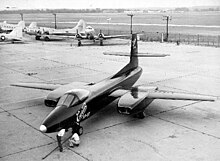Curtiss-Wright XF-87 Blackhawk
| XF-87 Blackhawk | |
|---|---|

| |
| Role | Interceptor |
| Manufacturer | Curtiss-Wright |
| First flight | 1 March 1948 |
| Status | Cancelled 10 October 1948 |
| Primary user | U.S. Air Force |
| Number built | 2 |
The Curtiss-Wright XF-87 Blackhawk (previously designated the XP-87) was a prototype American all-weather jet fighter interceptor and the company's last aircraft project.[1] Designed as a replacement for the World War II–era propeller-driven P-61 Black Widow night/interceptor aircraft, the XF-87 lost in government procurement competition to the Northrop F-89 Scorpion. The loss of the contract was fatal to the company; the Curtiss-Wright Corporation closed down its aviation division, selling its assets to North American Aviation.
Design and development
The aircraft started life as a project for an attack aircraft, designated XA-43. When the United States Army Air Forces issued a requirement for a jet-powered all-weather fighter in 1945, the design was reworked for that request.
The XP-87 was a large mid-wing aircraft with four engines paired in underwing pods, with a mid-mounted tailplane and tricycle undercarriage. Two crew members (pilot and radar operator) sat side by side under a single canopy. Armament was to be a nose-mounted, powered turret containing four 20 mm (0.79 in) cannon, but this was never fitted to the prototypes.
Operational history
The first flight of the XF-87 Blackhawk was on 1 March 1948.[2] Although the top speed was slower than expected, the aircraft was otherwise acceptable, and the newly formed (in September 1947) United States Air Force placed orders for 57 F-87A fighters and 30 RF-87A reconnaissance aircraft just over a month later. Since the performance problems were due to lack of power, the four Westinghouse XJ34-WE-7 turbojets of the prototypes were to be substituted for two General Electric J47 jets in production models. One of the two XF-87 prototypes was to be modified as a test bed for the new engines.
At this point, the USAF decided that the Northrop F-89 Scorpion was a more promising aircraft. The F-87 contract was cancelled on 10 October 1948, and both prototypes were scrapped.
Variants


- XP-87
- First flight was March 1, 1948
- XF-87
- Redesignated XP-87
- F-87A
- Production fighter version (canceled)
- RF-87A
- Reconnaissance variant (canceled)
Specifications (XF-87)
Data from Curtiss Aircraft 1907–1947[3]
General characteristics
- Crew: two: pilot, radio operator
Performance
- Climb to 35,000 ft (10,700 m): 13.8 min
Armament
- Guns: 4 × 20 mm cannon in the nose
See also
Aircraft of comparable role, configuration, and era
Related lists
References
- Notes
- Bibliography
- Bowers, Peter M. Curtiss Aircraft 1907–1947. London: Putnam, 1979. ISBN 0-370-10029-8.
- Buttler, Tony. American Secret Projects: Fighters & Interceptors 1945–1978. Hinckley, UK: Midland Publishing, 2008, First edition, 2007. ISBN 978-1-85780-264-1.
- Jenkins, Dennis R. and Tony R. Landis. Experimental & Prototype U.S. Air Force Jet Fighters. North Branch, Minnesota, USA: Specialty Press, 2008. ISBN 978-1-58007-111-6.
- Knaack, Marcelle Size. Encyclopedia of US Air Force Aircraft and Missile Systems: Volume 1 Post-World War II Fighters 1945–1973. Washington, DC: Office of Air Force History, 1978. ISBN 0-912799-59-5.
- Pace, Steve. X-Fighters: USAF Experimental and Prototype Fighters, XP-59 to YF-23. St. Paul, Minnesota, USA: Motorbooks International, 1991. ISBN 0-87938-540-5.
- Winchester, Jim. Concept Aircraft: Prototypes, X-Planes and Experimental Aircraft. Rochester, Kent, UK: Grange books plc, 2005. ISBN 1-84013-809-2.
